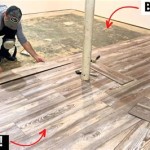Sheet Vinyl Flooring Roll Sizes: A Comprehensive Guide
Sheet vinyl flooring presents a practical and cost-effective solution for various flooring needs. Its resilience, ease of maintenance, and wide array of aesthetic options make it a popular choice for residential and commercial spaces alike. One crucial aspect to consider when selecting sheet vinyl is understanding the available roll sizes. This knowledge ensures efficient installation, minimizes waste, and ultimately contributes to a satisfactory flooring outcome.
Sheet vinyl, unlike tile or plank flooring, comes in large, continuous rolls. This characteristic minimizes seams, contributing to its waterproof nature and hygienic qualities. The size of these rolls, however, isn't uniform. Understanding the typical dimensions and factors influencing roll sizes is paramount for accurate calculations and effective purchasing decisions. This article offers a detailed exploration of sheet vinyl flooring roll sizes, providing essential information for consumers, contractors, and designers.
Standard Roll Widths for Sheet Vinyl Flooring
The width of a sheet vinyl roll is a primary factor dictating how efficiently a room can be covered. Wider rolls mean fewer seams, simplifying installation and improving the overall appearance. While variations exist based on manufacturer and product line, some standard widths are commonly available.
The most frequently encountered roll widths are 6 feet, 12 feet, and in some instances, 13 feet 6 inches. The 12-foot width is particularly popular, as it often allows for seamless installation in standard-sized rooms, typically those found in residential homes. The 6-foot width serves well in smaller spaces, such as bathrooms or hallways, where maneuverability and minimizing waste are key concerns. The 13 feet 6 inches width is often available for commercial application to support larger areas.
It is important to note that not all retailers carry all widths. Availability can depend on the manufacturer, distributor, and regional market. Therefore, verifying the availability of desired widths with local suppliers is a crucial first step in the selection process. Furthermore, larger retailers or those specializing in commercial flooring solutions are more likely to stock a broader range of sizes.
Choosing the appropriate width involves weighing several factors. The dimensions of the room or area to be covered are the most obvious consideration. However, installation complexity also plays a role. Handling wider rolls can be more challenging, especially in tight spaces or when working alone. Access to the installation area, including doorways and hallways, should be assessed to guarantee the roll can be transported and maneuvered effectively.
In cases where the room width necessitates joining two sections of sheet vinyl, proper seaming techniques become particularly critical. Professional installation is often recommended in such scenarios to ensure a watertight and aesthetically pleasing seam. Improperly executed seams can compromise the waterproof integrity of the flooring and detract from its overall appearance. Seam treatments and adhesives designed specifically for vinyl flooring are essential for achieving a durable and visually appealing result.
Variable Roll Lengths and Purchasing Considerations
While widths tend to be relatively standardized, roll lengths are far more variable. Sheet vinyl is typically sold by the linear foot or square foot, allowing customers to purchase the precise amount needed for their project. This contrasts with flooring sold in boxes, where purchasing additional material to account for waste is always required.
Roll lengths can range from a few feet to several hundred feet, depending on the manufacturer and the specific product. Retailers typically cut the desired length from the roll, providing the customer with a custom-sized piece. The length of the roll in the retailer’s inventory can influence the availability of very long, continuous pieces. Planning for the possibility of ordering multiple shorter pieces should be considered when unusually long runs are required.
When calculating the required amount of sheet vinyl, accurate measurements of the room are crucial. Using a laser measure or a high-quality measuring tape ensures precision. Add extra material – typically between 5% and 10% – to account for waste during installation, especially when dealing with complex room shapes or patterns. This allowance is particularly important when the flooring has a repeating pattern that requires careful matching.
Purchasing the correct amount of sheet vinyl minimizes waste and reduces costs. However, it is also important to consider potential future needs. Keeping some leftover material can be beneficial for repairs should the flooring become damaged later. While finding an exact match years later may prove difficult, even a slightly different color or pattern can provide a temporary solution. Storing leftover material properly, away from direct sunlight and extreme temperatures, is crucial to preserving its condition.
Furthermore, understanding the retailer's return policy is important. Some retailers may not accept returns on cut lengths of sheet vinyl, while others may offer a limited return period. Clarifying the return policy before making a purchase can prevent potential financial losses if the wrong amount of material is ordered.
Factors Influencing Sheet Vinyl Roll Sizes
Several factors contribute to the variations observed in sheet vinyl roll sizes. These factors relate to manufacturing processes, market demands, and the intended application of the flooring.
Manufacturing limitations play a role. The equipment used to produce sheet vinyl has inherent limitations in terms of width and length. Wider rolls require specialized machinery and may be more costly to produce. Similarly, the length of the roll is limited by the capacity of the winding equipment and the weight that can be safely handled during transportation and installation.
Market demands are also a significant influence. The prevalence of certain room sizes in residential construction drives the demand for specific roll widths. The popularity of 12-foot wide rolls reflects the common dimensions of bedrooms and living rooms in many modern homes. Consumer preferences for seamless flooring also contribute to the demand for wider rolls. Conversely, in markets where smaller apartments or rental units dominate, there is often greater demand for narrower rolls that minimize waste in smaller spaces.
The intended application of the flooring also influences roll sizes. Commercial applications, such as hospitals, schools, and retail spaces, often require wider rolls to cover large areas with minimal seams. These installations typically prioritize durability, ease of maintenance, and hygienic properties. Residential applications, on the other hand, may place greater emphasis on aesthetics and comfort. The specific requirements of each application influence the type of sheet vinyl selected and, consequently, the available roll sizes.
Furthermore, the type of vinyl flooring itself impacts the availability of roll sizes. Inlaid vinyl, which features a pattern that extends through the entire thickness of the material, may be available in different sizes compared to printed vinyl, where the pattern is simply printed on a surface layer. The manufacturing processes for each type of vinyl differ, leading to variations in the range of available roll sizes. The thickness of the wear layer, which determines the durability of the flooring, can also influence the roll size, with thicker wear layers sometimes requiring wider rolls for added stability.
Finally, transportation and handling considerations affect the final roll size. Large, heavy rolls of sheet vinyl can be difficult to transport and maneuver, particularly in residential settings. This limitation can impact the maximum width and length available, as manufacturers and distributors must balance customer demand with practical considerations for shipping and installation. The weight of the roll also affects the ease of installation, particularly for do-it-yourself projects. Wider, heavier rolls may require professional installation to ensure proper handling and alignment.

Sheet Vinyl Flooring Commercial Grade 6 To 12 Feet Sheets

Trafficmaster White Marble Residential Vinyl Sheet Flooring 10 Mil 12ft Wide X Cut To Length U6890 258c903p144 The Home Depot

Shaw Cascades 12 Wide Vinyl Sheet

Trafficmaster Portage Oak 10 Mil 12 Ft W X Cut To Length Waterproof Vinyl Sheet Flooring U4410406k731g14

Sheet Vinyl Flooring The Original One Piece Floor

Sheet Vinyl Flooring Guide

Vinyl And Lvt Carpet Portland Discount Flooring S

Heterogeneous Vs Geneous Sheet Vinyl Flooring Lx Hausys
Everything You Need To Know About Vinyl Flooring Tarkett

Beige Speckled Effect Non Slip Commercial Vinyl Flooring Roll For Usage In Restaurants Kitchens Gyms Hospitals With 2 0mm Thickness
Related Posts








